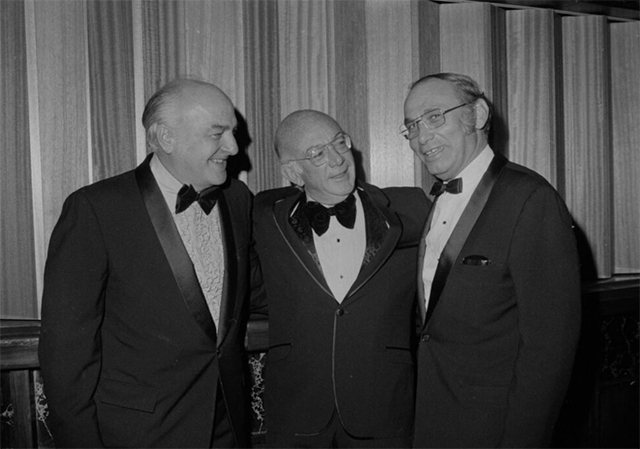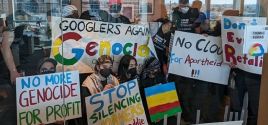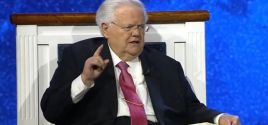
 The Anti-Defamation League ran an "extensive, multi-dimensional counterintelligence operation" complete with "undercover agents with code names" to destroy the influential anti-communist John Birch Society, internal ADL documents reveal. The Anti-Defamation League ran an "extensive, multi-dimensional counterintelligence operation" complete with "undercover agents with code names" to destroy the influential anti-communist John Birch Society, internal ADL documents reveal.
George Washington University professor Matthew Dallek was given access to "some" of the ADL's records on the spying operation from their historical archive for his new book, "Birchers: How the John Birch Society Radicalized the American Right."
From The Jewish Telegraphic Agency, "The historian who uncovered the ADL's spying operation against the far-right John Birch Society":
[Mathew] Dallek, who grew up in a Reform Jewish household in Los Angeles, recently sat with the Jewish Telegraphic Agency to discuss the rise of the Birchers, how the ADL infiltrated their ranks and whether such tactics are justified in the name of fighting extremism.
[...] JTA: Before we get into the Jewish aspect of the book, meaning the chapter on the Anti-Defamation League's relationship with the John Birch Society, let's take a step back. Who are so-called Birchers? Why do they matter?
Mathew Dallek: The John Birch Society was a household name in the 1960s, becoming the emblem of far-right extremism. It didn't have huge numbers, but it did penetrate the culture and the national consciousness. Its leader, Robert Welch, had argued at one point that President Dwight Eisenhower was a dedicated agent of a communist conspiracy taking over the United States. Welch formed the John Birch Society to educate the American people about the nature of the communist threat.
In its heyday, the group had about 60,000 to 100,000 members, organized into small chapters. They sent out literature trying to give members roadmaps or ideas for what they could do. They believed a mass education of the public was needed because traditional two-party politics was not going to be very effective at exposing the communist threat. They would form front groups such as Impeach Earl Warren [the Supreme Court's chief justice] or Support Your Local Police. They tried to ban certain books that they viewed as socialistic from being used in schools. Some Birchers ran for school board seats and protested at libraries.
Critics feared that the Birchers were a growing fascist or authoritarian group and that if they were not sidelined politically and culturally then the country could be overrun. The Nation magazine wrote that Birchers essentially had given their followers an invitation to engage in civil war, guerrilla-style. Those fears sparked a big debate about democracy. How does one sustain democracy and, at the height of the Cold War and in the shadow of World War II, Nazi fascist Germany, and the Holocaust?
As you were researching, you came across a trove of historical internal documents from the ADL in the archives of the American Jewish Historical Society in New York. Why did you devote a chapter to what you found in those documents? What did those files reveal to you about the John Birch Society?
These papers are a goldmine. They're this incredible and often detailed window into the far-right and, in particular, the John Birch Society. They show the ADL had an extensive, multi-dimensional counterintelligence operation that they were running against the Birch Society.
People knew at the time that the ADL was attending events where Birchers were speaking. But the ADL also had undercover agents with code names, who were able to infiltrate the society's headquarters in Belmont, Massachusetts, and various chapter officers. They dug up financial and employment information about individual Birchers. And they not only used the material for their own newsletters and press releases, but they also fed information to the media.
[...] Some critics of the ADL today say the organization has strayed from its mission by focusing not just on antisemitism but on a wider array of causes. But from reading your work, it sounds like the ADL even then took an expansive view of its role, examining not just direct attacks on Jews but also how the political environment can jeopardize Jews. Am I getting that right, and why did the ADL devote so many resources to a group like the John Birch Society?
So, a few things: It's the late '50s and '60s, and a civil rights coalition is emerging. Benjamin Epstein, the national director of the ADL, was friendly with Thurgood Marshall, the Supreme Court justice, and Martin Luther King. John F. Kennedy went to an ADL event and praised the ADL for speaking out very strongly in defense of democracy and pushing for the equal treatment of all Americans.
Isadore Zack, who helped lead the spy operation, at one point wrote to his colleagues that it was only in a democracy that the Jewish community has been allowed to flourish and so, if you want to defend Jewish Americans, you also have to defend democracy.
There certainly were other threats at the time, but the Birch Society was seen by liberal critics, including the ADL, as a very secretive group that promoted conspiracy theories about communists who often became conflated with Jews.
Would you consider the ADL successful in its campaign against the Birchers?
They were successful. They used surreptitious and in some cases underhanded means to expose the antisemitism and the racism and also interest in violence or the violent rhetoric of the Birch Society in the 1960s.
The ADL was at the tip of the spear of a liberal coalition that included the White House, sometimes the Department of Justice, depending on the issue, the NAACP, Americans for Democratic Action, labor unions, the union-backed Group Research Inc., which was tracking the far-right as well. The ADL was one of the most, if not the most effective at constraining and discrediting the society.
Clearly, however, the Birchers' ideas never died. They lived on and made a comeback.
It's somewhat ironic that you reveal the existence of this spying apparatus devoted to targeting an extremist and antisemitic group in the 1960s given the infamy the ADL would earn in a later era, the 1990s, for allegations that they colluded with police agencies in San Francisco to spy on and harass political activists. They eventually settled with the Arab American, Black and American Indian groups that brought a federal civil suit. I know you didn't study these revelations, which are outside the scope of your book, but could you perhaps reflect on why undercover tactics were seen as necessary or justified?
It's important to remember that in the mid-20th century, law enforcement in the United States was often led by antisemites or people who were much more concerned with alleged internal communist threats — the threat from the left.
From the ADL's vantage point, one could not rely on the government entities that were by law and by design supposed to protect Jewish Americans. There was a sense that this work had to be done, at least in part, outside of the parameters of the government.
When I first discovered the ADL's spying, I didn't quite know what to make of it. But I realized they weren't just spying to spy, they exposed a lot of scary things, with echoes in our own times — like easy access to firearms, a hatred of the government, a denigration and defamation of minority groups. And this was all happening in the shadow of the Holocaust and World War II. I became much more sympathetic; they were very effective, and they had a vision of equality of treatment for all Americans.
It's obviously controversial. I try not to shy away from it. But they had a lot of good reasons to fight back right and to fight back in this nonviolent way.
That last thought brings to mind another, right-wing Jewish group that existed in this era of taking things into our own hands, that did use violence, explosives even.
You mean the Jewish Defense League, led by Meir Kahane.
Yes, exactly.
He was a Bircher. Toward the end of my book, I mention that he was a member for a while, under his alias Michael King.
Antisemitism is on the rise, and lots of initiatives are being organized to address it, both by existing groups like the ADL and new ones. The ADL's budget has almost doubled over the past seven years. I am seeing Jews talk of fighting back and taking things into their own hands. And we are in this politically precarious movement in American history, all of which suggests parallels to the era you examined. What kind of wisdom can we glean from examining the ADL's secret and public fight against the John Birch Society as people who care about the issues affecting Jews today?
A lot of liberals in the 1960s and a lot of the leadership at the ADL grasped the axiom that things can always get worse.
In 2015-2016, you'll recall, there was Trump's demonization of Mexican immigrants, and the so-called "alt-right" around him and his campaign and expressions of vitriol by people like Steve Bannon.
There was an assumption among a lot of Americans and among a lot of Jewish Americans that the fringe right — the antisemites, the explicit racists, the white supremacists — that there's not a majority for them and they can never achieve power.
If you go back and you look at Trump's closing 2016 campaign ad, it's textbook antisemitism. He flashes on screen these wealthy Jewish international bankers, and he argues that basically, there's a conspiracy of these global elites who are stealing the wealth of honest Americans. There's also 2017, the white supremacists in Charlottesville, who said "Jews will not replace us" and Trump saying there are fine people on both sides.
The sense that democracy is incredibly fragile is not just a theory or a concept: It's an actuality, the sense as well, that the United States has only been a multiracial democracy for not very long and a haven for Jews for not that long either.
The work that the ADL and the NAACP and other groups did to try to constrain and discredit as fringe and extremist still goes on today. It's harder to do for all sorts of reasons today including social media and the loss of faith in institutions. But it still goes on. You see the importance of institutional guardrails including the Department of Justice that is prosecuting 1,000 Jan. 6 insurrectionists.
The last thing I'll say is that one of the admirable things in the 1960s about the ADL and the liberal coalition it belonged to is that it built support for landmark legislation like the Immigration Act of 1965, the Civil Rights Act of 1964, and the Voting Rights Act of '65. And a coalition eventually fell apart, but it was powerful, reminding us why Jewish American groups should care about or focus on issues that don't directly affect Jewish people. City Journal has more in their review of Dallek's book:
Dallek's most significant contribution involves revealing a "previously undisclosed counterintelligence operation waged by the [Anti-Defamation League] to infiltrate and dig up damaging information about the John Birch Society." He notes how the so-called Birch Watchers tried to bait JBS leaders by issuing racist statements in their presence and how they even "posed as disgruntled Birchers to infiltrate white supremacist groups and assess the society's existing ties to them." He reveals that, in addition to the FBI, the press received reports that compiled the most unflattering material and that the targets of such operations "sometimes found their careers in jeopardy."
The code-name-using Birch Watchers included cops, bankers, and others privy to sensitive information. Dallek writes: "They obtained chapter membership lists, ran credit reports on individual Birchers, ferreted out their employment records, traced their financial transactions, wrote down their license plate numbers, obtained a codicil to a Bircher donor's will, stumped them with tough questions during call-in radio shows, set up a Birch chapter meeting on false pretenses so an ADL target could be ‘interviewed,' and studied their personal and professional associations. Some of the scariest or most unflattering bits ended up in the press."
One suspects that some of the scariest or most unflattering bits did not end up in Dallek's book. He notes in his acknowledgments that the ADL "kindly allowed me to review some of the historical records in its archives." Some of the historical records? All these years later, the ADL has basically merged with the FBI and together they're using the same Stasi-like tactics to suppress the right.
Former FBI Director James Comey in 2014 delivered a speech which he described as a "love letter" to the ADL and in 2017 he told ADL CEO Jonathan Greenblatt during another speech, "Three years later I can say, from the perspective of the FBI, we're still in love with you."
"You have advocated for voting rights and immigration issues," Comey said. "You have fought against anti-Muslim prejudice and cyber bullying. You have stood up for LGBT and gender equality. You have pushed and prodded for hate crime legislation. And you have helped us identify and track domestic and international terrorist threats. And for all of that, we are grateful."
The average American is a MAGA extremist who must be put on an FBI watchlist for speaking out against critical race theory at a school board meeting but the ADL and their "multi-dimensional counterintelligence operation" that's used to subvert the will of the American people deserves nothing but praise!
[Header image shows Isadore Zack, Benjamin Epstein, and Sol Koloack at B'nai B'rith Anti-Defamation League dinner in 1971. Leo Renahan/Digital Common Wealth, CC BY-NC-ND 4.0]
Follow InformationLiberation on Twitter, Facebook, Gab, Minds and Telegram.
|






 The Anti-Defamation League ran an "extensive, multi-dimensional counterintelligence operation" complete with "undercover agents with code names" to destroy the influential anti-communist John Birch Society, internal ADL documents reveal.
The Anti-Defamation League ran an "extensive, multi-dimensional counterintelligence operation" complete with "undercover agents with code names" to destroy the influential anti-communist John Birch Society, internal ADL documents reveal.


